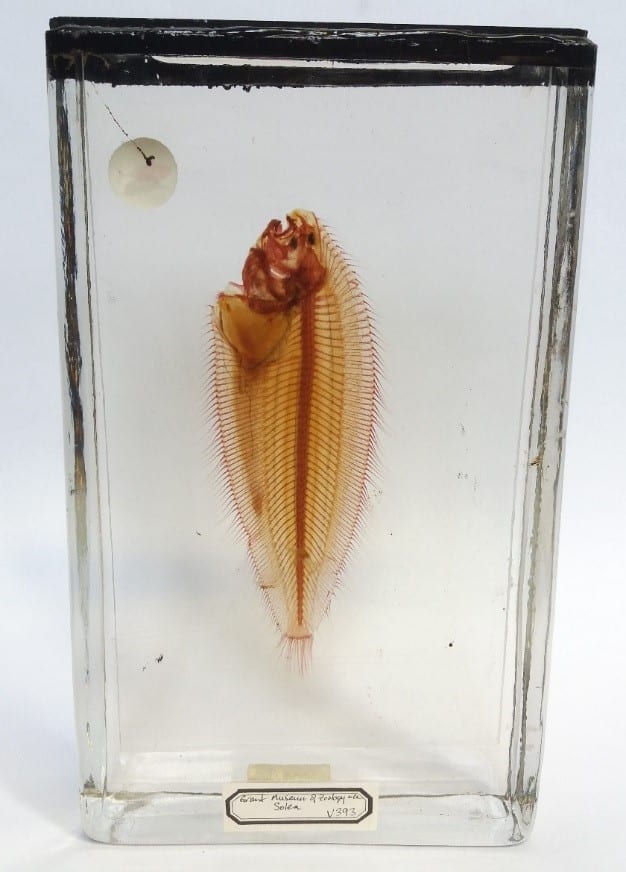Specimen of the Week 342: Alizarin stained sole
By Christopher J Wearden, on 11 May 2018
Happy Friday to all Specimen of the Week readers. For my first specimen of the week post I decided to get started with an animal that could be considered ‘exotic’ due to its distribution (tropical Australia and New Guinea) and relatively unknown status (most people will tell you couscous is a food, not an animal). For my second post I’ve chosen a well-known animal which can be found much closer to home, it’s the…
**Alizarin stained sole**
The common sole (solea solea) is a species of flatfish in the Soleidae family. Common sole live on the seabeds of the northern Atlantic Ocean, the Mediterranean Ocean and the North Sea. As you can see our specimen has received an Alizarin-stain makeover, which allows us to see its bone structure (and makes it very photogenic). If you’re reading the word ‘Alizarin’ for the first time please don’t worry, there will be more on this later.
Things are looking up
An obvious characteristic of the common sole and other flatfish is their asymmetry. Soles begin life as a bilaterally symmetric larvae, with an eye on each side of the head. During development these eyes migrate, so that by the time they become adults both eyes lie on the same side of the head. This leaves them with a sighted (up) and blind (down) side. Although being blind on one side might seem disadvantageous to us, it is actually an evolutionary development perfectly suited to a life lying flat on the seabed. The side facing up is camouflaged which helps as a defence against predators and also helps with hunting; the sole can lay motionless and unseen for hours, waiting for a small morsel to swim by. Sole feed primarily on small crustaceans, shrimps, bivalves, worms and bottom dwelling invertebrates.

Three-eyed flounder (ancylopsetta dilecta) where both eyes have migrated around the head. Pascagoula Laboratory; Collection of Brandi Noble. CC-BY-2.0
The sole reason
The sole reason soles are called soles is became the Romans thought soles resembled sandals (solea = sandal in Latin). Now there’s a sentence with a lot of sole.
Alizarin staining
Alizarin is an organic compound which has been used through history as a red dye, initially for fabrics but also for scientific purposes in biology and medical experiments. Alizarin is made from dyer’s madder, a herbaceous perennial plant species belonging to the bedstraw and coffee family Rubiacae. Alizarin’s abilities as a biological stain were first noted in 1567, when it was observed that the bones turned red when fed to animals. Cases 92 and 93 at the Grant Museum contain specimens which have been Alizarin stained.
Conservation
According to the University of Washington’s Conservation Magazine, there has been a shift in flatfish fishing from catching youngsters on nursery grounds to trawling adults on spawning grounds. This trend is also evident in sole fishing; the Marine Conversation Society recommends on their website that people should avoid buying immature sole (less than 30cm) and fresh fish caught during the breeding season (April-June).

Common sole. © Hans Hillewaert / CC BY-SA 4.0
References
http://www.conservationmagazine.org/2008/07/even-a-billion-flatfish-are-still-inbred/
Chris Wearden is the Visitor Services Assistant at the Grant Museum of Zoology.
 Close
Close


